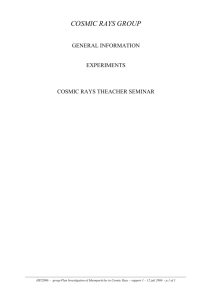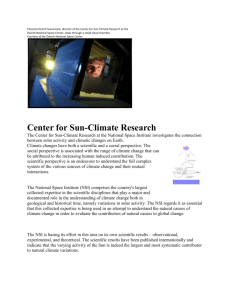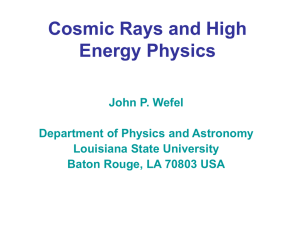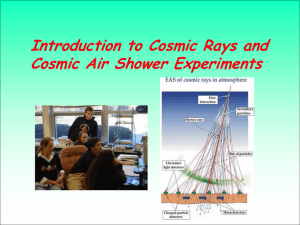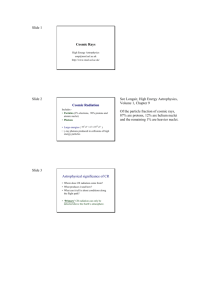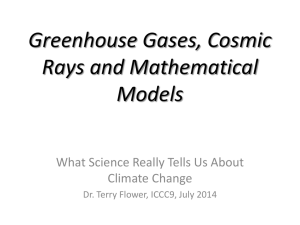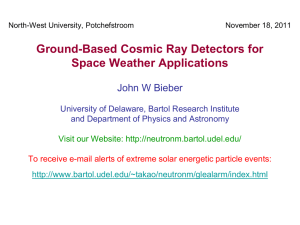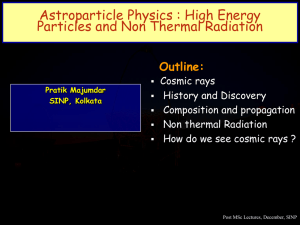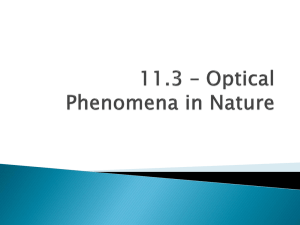PowerPoint Presentation - Cosmic Rays
advertisement
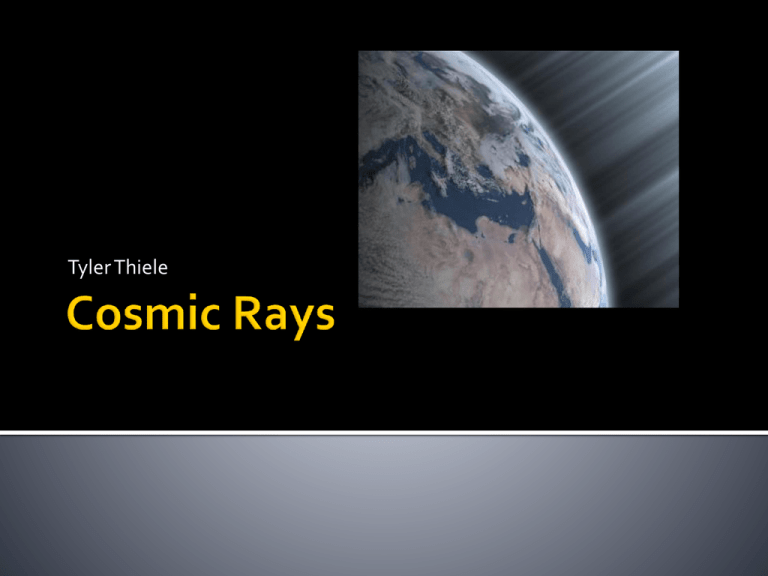
Tyler Thiele Cosmic rays are high energy charged particles, in outer space, that travel at nearly the speed of light and strike the Earth from all directions. Most cosmic rays are the nuclei of atoms, ranging from the lightest to the heaviest elements in the periodic table. Cosmic rays also include high energy electrons, positrons, and other subatomic particles. 89% protons (hydrogen nuclei) 10% Helium nuclei 1 % Electrons, heavier elements Extra-solar cosmic rays (all those except those emitted by the sun as solar flares), also known as Galactic Cosmic Rays, originate and are accelerated to nearly the speed of light by supernovae explosions. The cosmic rays that arise in extra-solar astrophysical sources are primary cosmic rays; these primary cosmic rays can interact with interstellar matter to create secondary cosmic rays. The Sun also emits low energy cosmic rays associated with solar flares. Cosmic rays were first discovered and coined by Victor Hess in 1912. He detected radiation in the upper atmosphere using an electroscope in a balloon. To determine whether or not the radiation was coming entirely from the sun, he repeated the experiment during a nearly complete solar eclipse. Hess determined that “essentially, the sun could not be the source of cosmic rays, at least as far as the undeflected (by the solar eclipse) rays were concerned.” Hess was awarded the Nobel Prize in 1936 for this discovery. Following the discovery there was a debate between American physicists Robert Millikan and Arthur Compton about the nature of the cosmic rays. Millikan asserted that cosmic rays were composed of high energy photons (bases of electromagnetic spectrum), while Compton claimed that they were composed of charged particles. Compton was eventually proven correct. Following an experiment which involved cosmic rays passing through a cloud chamber, it was further proven that cosmic rays behaved like charged particles when passing through a magnetic field in the cloud chamber and therefore are not a form of electro-magnetic radiation. Flux: number of particles per unit area per second. The flux of cosmic ray particles as a function of their energy. The flux for the lowest energies (yellow zone) are mainly attributed to solar cosmic rays, intermediate energies (blue) to galactic cosmic rays, and highest energies (purple) to extragalactic cosmic rays When cosmic ray particles enter the Earth's atmosphere they collide with molecules, mainly oxygen and nitrogen, to produce a cascade of lighter particles, a so-called air shower. The general idea is shown in the next figure which shows a cosmic ray shower produced by a high energy proton of cosmic ray origin striking an atmospheric molecule. Cosmic rays ionize the molecules in the atmosphere, which leads to a number of chemical reactions, including the ionization of water. Due to its lacking of empirical evidence, the theory that solar variation has a significant effect on the climate (by affecting cloud cover) has been overshadowed in favor of the “politically correct” man-made greenhouse gas theory. Cosmic rays could be the link between solar variation and cloud cover on earth, and therefore have a significant effect on the climate. When clouds form they contain millions of water droplets in each cubic meter of air. Each of the cloud droplets forms on a particle. A collection of particles is called an aerosol. In cloud formation, one particle produces one water droplet, so there are the same number of particles as there are water droplets. The aerosol particles come from natural processes as well as human activities. They are made of soil, dust, and sea salt, or from air pollution from cars, power plants, and factories. During cloud formation, water vapor (which is also contained in air) condenses on the aerosol particles. Charged water droplets combine with aerosol particles 10-100 times more efficiently than uncharged ones. Thus the ions created by cosmic rays entering the atmosphere will enhance the efficiency of cloud formation. Correlation Between Cosmic Ray Flux and Cloud Cover. http://www.fakeclimate.com/arquivos/Interna cional/HenrikSvensmark/svensmark_96_variat ions%20of.pdf Cosmic rays fit as the mechanism for the aforementioned solar theory, because the cosmic ray flux on the earth is dependent on solar activity. The Earth’s magnetic field also plays a part in deflecting cosmic rays. The sun and the Earth both have magnetic fields that deflect incoming cosmic rays. This divides cosmic rays into three categories: Low energy rays that are deflected by the Earth’s magnetic field. Medium-energy rays that are deflected by the sun’s solar wind and/or magnetic field. High energy rays that are not deflected by either field. 60 % of the ionized particles that originate from GCRs are from the high-energy category, and therefore cannot be blocked. However, the other 40% come from medium energy GCRs and therefore are under the influence of the solar wind and the sun’s magnetic field. Total cloud cover (solid red line) and low cloud cover (broken blue line) as obtained from infrared (low clouds) and visual plus infrared (total cloud) observations. The thin black line represents the Climax Cosmic Ray Flux scaled for comparison. Cosmic rays are a likely link between solar activity and earth’s temperature. The sun regulates 40% of the GCR spectrum (and that 40% is more likely to strike the Earth). As this 40% varies with solar activity, so then does cloud cover and temperature.
